Day 5, Tuesday, Nov 28, 2023: Egyptian museum, Coptic museum, Citadel
EGYPTIAN MUSEUM
we walked to the Egyptian museum for our 3rd and final visit. Oh, what convenience the Cairo pass was!
Royal sandals, used ones are smaller, the other big ones are for show, with make believe that the Pharoah was much bigger than he actually was.
Mummy with fayum painting for the face mask
MUST SEE ROOMS WITH GOLD, SILVER COFFINS AND FUNERARY GOODS
Then we were at the entrance of the must see rooms. .. below is the reused outer granite coffin of Psusennes I, right corner is Tutankhamun's gold leaf canopic chest, in the back Tut's Ka statue stands
Tut's canopic jars
Tut's canopic jars
Silver Coffin of Psusennes I 1047-1001 BC.
Psusennes I was one of three late period kings (21st-22nd Dynasties) whose burials were found more or less intact at the site of the ancient city of Tanis to the north-east of Egypt’s Delta region.The silver coffin of Psusennes I is especially remarkable (silver being considered rare than gold in Egypt) and bears the likeness of the King, as does the stunning gold mask found within placed on the mummy (which did not survive beyond mere bones)The lid of this silver mummy-shaped coffin portrays King Psusennes I as a mummy. His arms crossed over his chest holding the flail and the scepter. There is a solid gold uraeus, or royal cobra, on his forehead to protect him. The face is decorated with a band of gold across the forehead; the eyes are inlaid with colored glass paste.
On the chest and abdomen there are representations of three birds with outspread wings, grasping the Shen signs of eternity. The rest of the coffin lid is decorated with long feathers. Images of Isis and Nephthys are shown on the lid at the level of the feet.
SOLID GOLD Mask of Psusennes I
Covering the head of the wrapped mummy in its coffin and activated by a magical spell, no.151b from the Book of the Dead, the mask ensured more protection for the king’s body.
In this gold mask, Psusennes I appears with the royal headdress surmounted by the uraeus, or royal cobra. He wears a divine plaited false beard. The mask is made of two pieces of beaten gold, soldered and joined together by five nails that can be seen from the back. The king wears the royal nemes headdress, usually made of linen, surmounted by the sacred uraeus, the royal cobra.
He also wears a broad usekh or wesekh broad collar incised with floral decorations. The inlays of the eyelids and eyebrows and the straps fixing the beard are of glass paste. The eyes are made of black and white stone.
This golden mummy plaque covered an incision in the abdomen caused by embalmers removing internal organs during mummification.
The plaque was supposed to restore the body to its original state of strength as the wound was vulnerable and a possible entry point for negative forces. It is decorated with the Wadjet or Eye of Horus, as the symbol was associated with the idea of physical wholeness and protection. The Four Sons of Horus are praying to the Wadjet eye. They most commonly appear as the guardians of the canopic jars, where the entrails of the deceased are interred. Each deity’s name is inscribed above his head.
In this gold mask, Psusennes I appears with the royal headdress surmounted by the uraeus, or royal cobra. He wears a divine plaited false beard. The mask is made of two pieces of beaten gold, soldered and joined together by five nails that can be seen from the back. The king wears the royal nemes headdress, usually made of linen, surmounted by the sacred uraeus, the royal cobra.
He also wears a broad usekh or wesekh broad collar incised with floral decorations. The inlays of the eyelids and eyebrows and the straps fixing the beard are of glass paste. The eyes are made of black and white stone.
This golden mummy plaque covered an incision in the abdomen caused by embalmers removing internal organs during mummification.
The plaque was supposed to restore the body to its original state of strength as the wound was vulnerable and a possible entry point for negative forces. It is decorated with the Wadjet or Eye of Horus, as the symbol was associated with the idea of physical wholeness and protection. The Four Sons of Horus are praying to the Wadjet eye. They most commonly appear as the guardians of the canopic jars, where the entrails of the deceased are interred. Each deity’s name is inscribed above his head.
SILVER COFFIN [Silver was more expensive than gold then]
Gold sheet drape for the mummy
Exquisite jewelry buried with King Psuesenes I , 21st dynasty
Heart scarab/divine beetle as good luch charm in the middle of the pendant
pic of Tut's tomb as found
TUT ANKH AMUN
Tutankhamun's innermost coffin, solid gold 100 kg
Tutankhamun's mask, 10 kg solid gold
other halls were basically deserted...
models found as funerary goods
Boat models
mummified food... duck
funeral boat with the mummy
Figurines
Ushabtis which were supposed to do errands for the King in the after life
Mummy
Mummy
carriage of Yuya, Thuya [royal parents]
Papyrus with religious verses buried in the tomb
models found as funerary goods
Boat models
mummified food... duck
funeral boat with the mummy
Figurines
Ostrich feather fan
MummyUshabtis which were supposed to do errands for the King in the after life
Mummy
Mummy
carriage of Yuya, Thuya [royal parents]
Papyrus with religious verses buried in the tomb
Ostraca...
these are doodles the workers made when they were cutting the royal tombs. Quite interesting they had some fun in the midst of hard work
ushabtis again
canopic jars holding the mummified internal organs
striding Pharoahs
sarcophagus from Roman age
False door from a tomb [which wil lead the king to heaven]
statues of a carpenter with his family... got from his family tomb
Pharoah Ramses II flanked by Horus and Seth
ushabtis again
canopic jars holding the mummified internal organs
striding Pharoahs
sarcophagus from Roman age
False door from a tomb [which wil lead the king to heaven]
statues of a carpenter with his family... got from his family tomb
statue of King Khafre
found in the Valley Temple of Khafre’s pyramid complex near the Great Sphinx It was one of about 23 identical statues.e (ca.2472-2448 BC). Height 168 cm
Triad of Menkaure
between Hathor and the the personification of one of the provinces (called nomoi) of the Upper Egypt with his respective emblem.(2447-2448 BC) These triads, superbly sculpted in a single block of stone and originally painted in bright colours, were found intact in the valley temple of the Menkaure’s pyramid
This small statue found in 1903 is the only known three-dimensional representation of King Khufu (called by the Greeks Cheops), the builder of the Great Pyramid at Giza. Khufu is represented seated on a throne wearing the crown of Lower Egypt (damaged) and holding a flail in his right hand. On the right side of the throne is carved his name: Khufu is the abbreviated form of “Khnum-khuefui” (Khnum protects me). (ca. 2589 – 2566 BC)
Mashrabiyya (Arabic: مشربية) is an architectural element which is characteristic of traditional architecture in the Islamic world and beyond.
Size: Height: 7,5 cm Lenght: 2,5
Place of discovery: Abydos (Upper Egypt) – Temple of Osiris at Kom el-Sultan
Material: Ivory
COPTIC MUSEUM
The Coptic Museum has the largest collection of Coptic Christian artifacts in the world. Copts are a Christian ethnoreligious group indigenous to North Africa who have primarily inhabited the area of modern Egypt and Sudan since antiquity.
Originally referring to all Egyptians, the term Copt became synonymous with native Christians in light of Egypt's Islamization and Arabization after the Muslim conquest of Egypt in the 7th century
Egypt is identified in the Bible as the place of refuge that the Holy Family sought in its flight from Judea. When the Church of Alexandria was founded by Mark the Evangelist during the reign of the Roman emperor Nero, a great multitude of native Egyptians (as opposed to Greeks or Jews) embraced the Christian faith.
Note the balcony/mashrabiyyaMashrabiyya (Arabic: مشربية) is an architectural element which is characteristic of traditional architecture in the Islamic world and beyond.
It is a type of projecting oriel window enclosed with carved wood latticework located on the upper floors of a building, sometimes enhanced with stained glass. It was traditionally used to catch wind and for passive cooling. Jars and basins of water could be placed in it to cause evaporative cooling. It is most commonly used on the street side of the building; however, it may also be used internally on the sahn (courtyard) side
AMAZING WOOD CEILING
another amazing ceiling
gold lettering
mashrabiyyah
amazing ceiling
mashrabiyyah
the fortress complex is divided into two parts: the Northern Enclosure (where the National Military Museum is located today), and the Southern Enclosure (where the Mosque of Muhammad Ali is located today)
Sitting on a hill overlooking Cairo, the citadel was the seat of government for the rulers of Egypt for over 600 years. The Citadel stopped being the seat of government when Egypt's ruler, Khedive Ismail, moved to his newly built Abdin Palace in the new downtown Cairo in 1874.
Ali ordered the mosque to be built on the site of Mamluk buildings he had razed inside the then-700-year-old Citadel of Saladin overlooking Cairo. (Ali later invited the remaining Mamluk leadership to the Citadel under the guise of a celebration, and then had them all slaughtered on arrival.)
Courtyard of the Mosque
Interior of the Mosque, featuring mihrab and minbar.
AMAZING WOOD CEILING
another amazing ceiling
gold lettering
mashrabiyyah
amazing ceiling
mashrabiyyah
THE CITADEL/ Saladin Citadel on Pharaoh’s Island
construction begun ca. 1116
Saladin Citadel, also known as Cairo Citadel, is located on Mugaitam Mountain in the eastern suburbs of Cairo. the site contains remnants of Byzantine-era buildings,
Crusaders built the original fort on this island in the Gulf of Aqaba in the early twelfth century during the reign of Baldwin I, King of Jerusalem, to aid in their control of one of the major routes between Cairo and Damascus.
The Arab general and Islamic dynasty Ayyubid founder Saladin conquered the island and surrounding area in 1170-1171. He ordered this citadel built in 1176 to unite the cities of Cairo and Fustat, and also to provide a key point of defense against the Crusaders in the capital of his new caliphate.
Sitting on a hill overlooking Cairo, the citadel was the seat of government for the rulers of Egypt for over 600 years. The Citadel stopped being the seat of government when Egypt's ruler, Khedive Ismail, moved to his newly built Abdin Palace in the new downtown Cairo in 1874.
The Muhammad Ali Mosque or Alabaster Mosque (Arabic: مسجد محمد علي)
this Ottoman mosque is the largest to be built in the first half of the 19th century. The mosque was built in memory of Tusun Pasha, Muhammad Ali's eldest son, who died in 1816.The mosque was built with a central dome surrounded by four small and four semicircular domes. It was constructed in a square plan and measured 41x41 meters.
The central dome is 21 meters in diameter and the height of the building is 52 meters. Two elegant cylindrical minarets of Turkish type with two balconies and conical caps are situated on the western side of the mosque, and rise to 82 meters.
The use of this style, combined with the presence of two minarets and multiple half-domes surrounding the central dome — features reserved for mosques built on the authority of the Sultan — were a defiant declaration of de facto Egyptian independence.The mosque represents in some ways Muhammad Ali’s rebuke of the several centuries of Mamluk rulers and cultural dominance that preceded him in Egypt. Ali, who was an Ottoman army commander of Albanian origin, adopted the architectural style of the country’s former imperial overlords when he chose the design of the mosque, something the Mamluks avoided. The architect is said to have used the Sultan Ahmed Mosque [blue mosque] in Istanbul as a model for his design.
The alabaster covered interior. The walls and pillars are covered with alabaster up to 11 meters high
Minbar of the mosque
Interior of the domes.
Minbar of the mosque
Interior of the domes.
The Sultan al-Nasir Muhammad ibn Qalawun Mosque
is an early 14th-century mosque at the Citadel. It was built by the Mamluk sultan Al-Nasr Muhammad in 1318 as the royal mosque of the Citadel, where the sultans of Cairo performed their Friday prayers. The mosque is located across the street from the courtyard access to the Mosque of Muhammad Ali. [Sultan al-Nasir Muhammad was one of the sons of Sultan Qalawun (d. 1290). He was reportedly short, had a lame foot, and a cataract in one eye as well. However, he still managed to rally the support of his people because he was smart and energetic. He became Sultan at 9 years, had to go away when others usurped and ruled. He returned and ruled, was usurped another time before finally reinstated. He built these building projects then. He also managed to remain on good terms with other countries.]
The most striking and unique feature of this mosque are its two minarets. The first is placed at the north-east corner of the Mosque where it could call troops to prayer. The other is also near the main entrance. What makes these minarets unique is their bulbous sections with finely carved decoration. Other minarets from the time are not nearly as extensively decorated
The hypostyle mosque is built as a free-standing 63 x 57 m rectangle around an inner court with a sanctuary on the qibla side and galleries surrounding the other three sides.Courtyard of the Mosque
Interior of the Mosque, featuring mihrab and minbar.
Report continues here





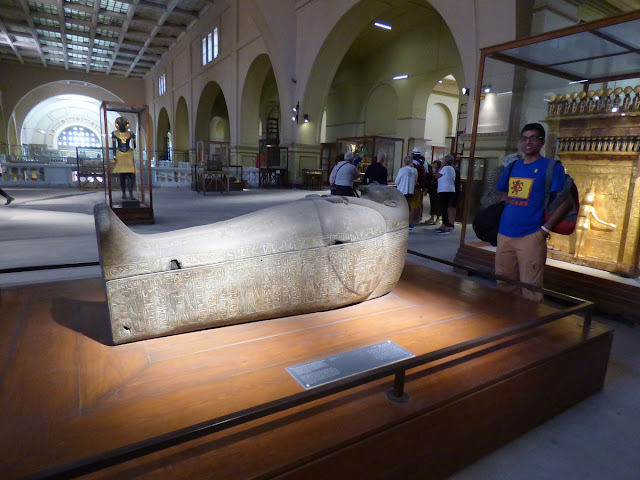






























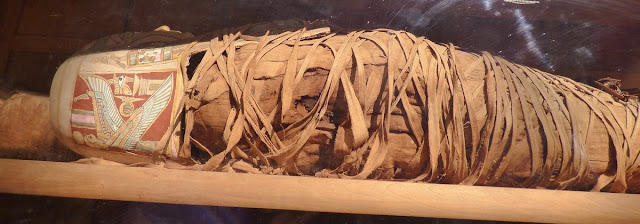
























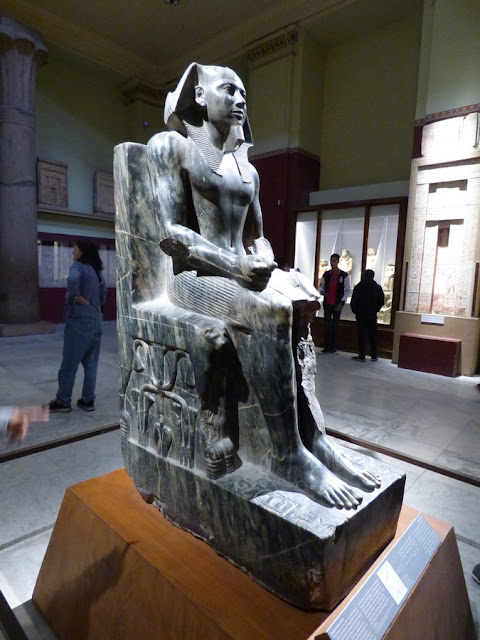


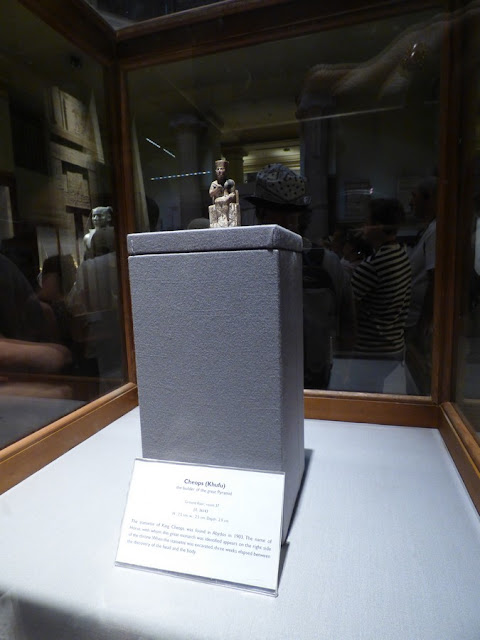





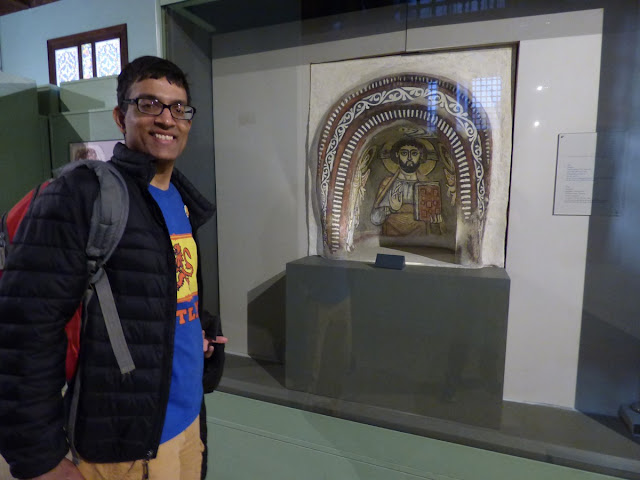





















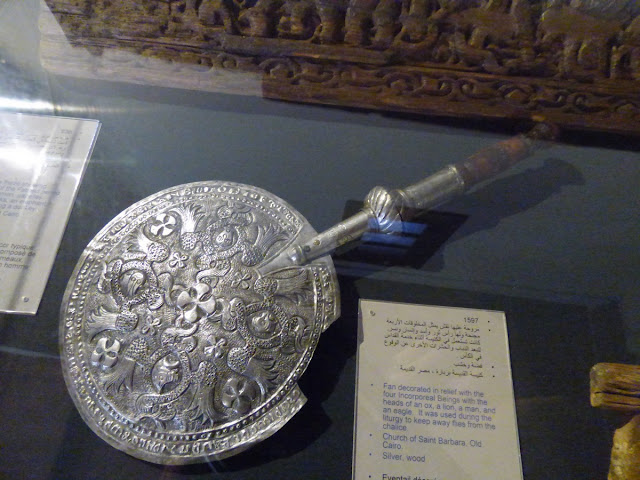













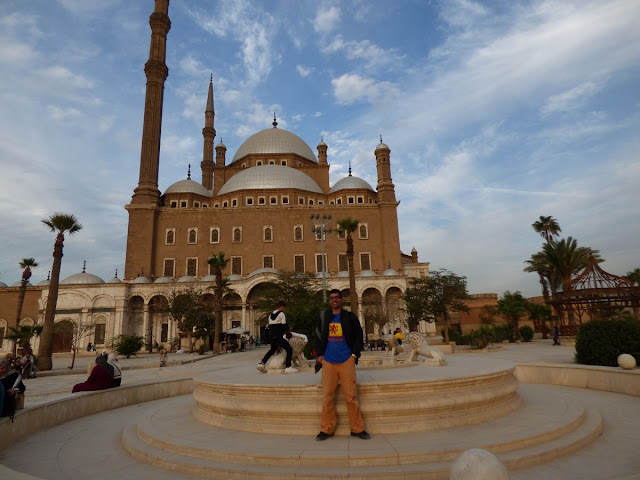



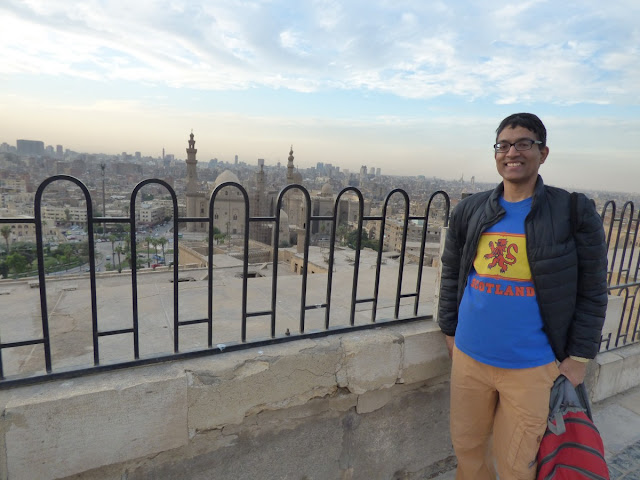

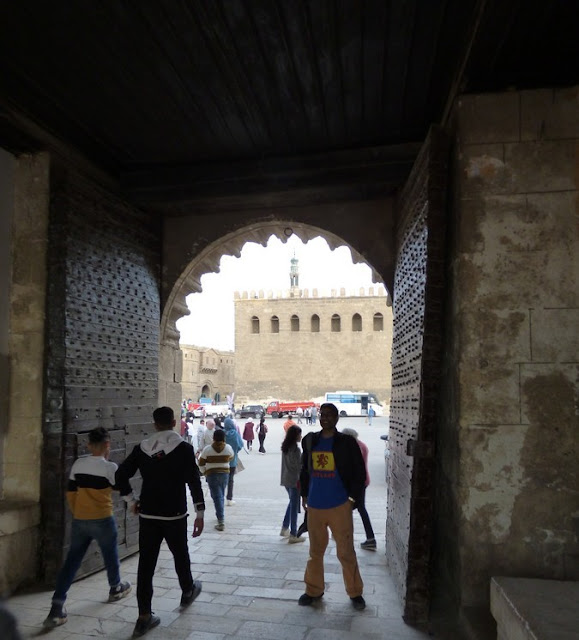





No comments:
Post a Comment